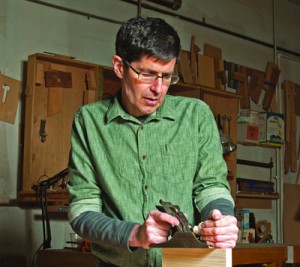We may receive a commission when you use our affiliate links. However, this does not impact our recommendations.
 Woodworking author and instructor Jeff Miller is a furniture designer, craftsman, teacher and author. His books include “The Foundations of Better Woodworking” and “Chairmaking and Design” among others. (Also, don’t miss Jeff’s new Design & Techniques for Building Curvy Furniture DVD). His furniture has been shown in galleries and shows nationwide and is included in the Decorative Arts Collection of the Chicago History Museum. This September Jeff will be teaching at Woodworking In America. His sessions will cover bent lamination and chair design as well as approaches to curved work. He was kind enough to spare a few moments from his busy schedule to answer a few questions.
Woodworking author and instructor Jeff Miller is a furniture designer, craftsman, teacher and author. His books include “The Foundations of Better Woodworking” and “Chairmaking and Design” among others. (Also, don’t miss Jeff’s new Design & Techniques for Building Curvy Furniture DVD). His furniture has been shown in galleries and shows nationwide and is included in the Decorative Arts Collection of the Chicago History Museum. This September Jeff will be teaching at Woodworking In America. His sessions will cover bent lamination and chair design as well as approaches to curved work. He was kind enough to spare a few moments from his busy schedule to answer a few questions.
As a furniture designer, teacher and book author, your approach to the craft of woodworking is multi-faceted. On which aspect of your woodworking life is most of your time spent these days and why?
I really enjoy the multi-faceted approach to woodworking that has developed for me over the years. The woodworking and design are at the root of it all, but the writing and the teaching are every bit as interesting and demanding in their own ways. Together, all of these form a very rich and satisfying whole. I’ve been finding that the growth of the writing and teaching have been very positive for my furniture design and making – I’m able to develop new designs now that I never had time to do when I just relied on making furniture. At the moment, the balance is very nearly even between the different elements; no one aspect dominates. I’m sure that will change over the years, but I like this balance.
 Your latest book, “The Foundations of Better Woodworking,” covers both hand tool techniques and power tool techniques. Do you have a preferred method of working or does it just depend on the workpiece? What’s your process?
Your latest book, “The Foundations of Better Woodworking,” covers both hand tool techniques and power tool techniques. Do you have a preferred method of working or does it just depend on the workpiece? What’s your process?
I try to work efficiently in my woodworking, and that means that there are many things that I will do by machine, and many other things that I’ll do by hand. I don’t take a dogmatic approach to my work; my tools help me to realize my designs and get the work done. I apply my skill to using all of my tools well. The balance between hand tool work and machine work actually changes depending on the specific job, and also on whether I’m working on a prototype or building a fully-worked out design. Prototype work tends to be hand-tool heavy. There’s no point in setting up machines or building jigs when the design is evolving and may change many times before I finish. I’ll even cut some of the joinery on more complex pieces by hand during this stage. But once I know what I’m doing, I will often set up more efficient ways to do various tasks.
How would you say your woodworking approach has evolved over time?
The changes in my woodworking and in my design over the years I’ve been doing this are significant. I always used a combination of hand tools and machines, but both types of work have gotten much more sophisticated over the years. I also think that my designs have evolved from largely Shaker and Craftsman influenced work to designs that are more in my own style.
Is there anything you wish you could help your students understand early on that took you a long time to discover?
I think that “The Foundations of Better Woodworking” is a pretty complete compilation of just that sort of knowledge; hard won over years of work, and not generally available in other books, articles or videos. There aren’t any secrets, though. You just have to do a lot of work and start with good fundamentals.
What are you currently working on?
I just finished designing a new rocking chair. The next step is designing how I’m going to make multiples of it. The first version relied very heavily on hand tool skills. But I will create some simple jigs to help me build the next ones. I’ve got a bunch of other designs in early stages, but nothing I’ve actually started building yet.
One reason I haven’t started in on the new designs is that I’m working on my new book on furniture design. I think that design is an area where most people still have very little understanding of the process or of the tools used. I hope to be able to fill some of that void with some practical knowledge.
What are you looking forward to most at WIA?
There are so many things going on at WIA. But to me, the most important thing is the sense of community among woodworkers. WIA gives us a chance to share information both in the sessions, but also in casual ways outside of the sessions. What we do is usually done alone, and this is a huge group of people eager to share what they’re up to. I find that inspirational and energizing.
 Don’t miss Jeff Miller at Woodworking In America, September 25-27, 2015. Click to learn more about WIA.
Don’t miss Jeff Miller at Woodworking In America, September 25-27, 2015. Click to learn more about WIA.
Here are some supplies and tools we find essential in our everyday work around the shop. We may receive a commission from sales referred by our links; however, we have carefully selected these products for their usefulness and quality.









I have read Jeff Miller’s books and think that The Foundations of Better Working is the best woodworking book on the market today. It is one of those books that you don’t want to end. I have read the entire book twice and still refer back to it. I have his DVD on order and can’t wait for his new book on design to come out.